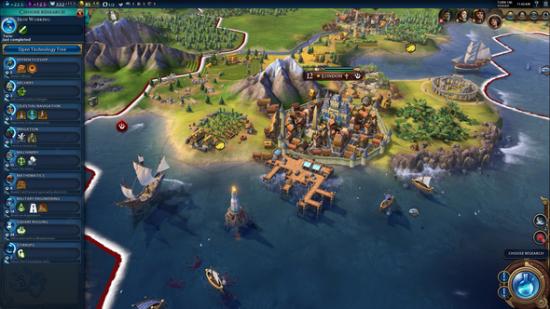If Civilization VI were an eSport, you wouldn’t see me in any arenas, clicking frantically at my gaming chair next to my team-mates, all wearing the same polo shirt. My mind just doesn’t operate on that level – stupid, is what it’s called. However, I’ve been playing the series long enough to develop a few strategies for my chosen civilizations, making use of their unique units and perks, that just about keep me out of trouble on Warlord difficulty. Or Chieftan, if no-one’s looking when I’m at the game setup screen.
Lately that Civ of choice has been Japan. In Civ V, the Japanese Samurai are an indomitable Medieval era combat unit that also offer the ability to deploy fishing boats on ocean food tiles without depleting themselves. That’s a huge perk, because fishing boats generate +2 culture a pop for the Japanese. Every atoll within your borders generates an extra +2 culture too. Every combat unit also has Bushido, which allows them to fight as though they’re at full strength even when they’re damaged.
Read more: here’s all we know about Ciziliation 6 so far.
That makes Japan a great shout for a domination or culture victory, and for a Warlord (alright, Chieftan) like me, it makes the path to those outcomes fairly straightforward. Research everything that leads to Samurai as early as possible, secure an iron resource, and start bashing skulls. Or: make a boatload of, er, boats and secure every atoll on the map to gain the cultural advantage.
Now the interesting bit: I recently got the chance to sit down and play 150 turns with Japan in Civilization VI. Usually it’s hard to draw direct comparisons between a new game and its predecessor at preview stage, but this was a perfect opportunity to determine the effect and value of each change Firaxis have introduced to this Civ.
Would my established Civ V strategy steer me on the path to another successful domination victory in this game too? Perhaps even that silver tuna, the culture victory? Or, would Civ VI’s new elements such as its city districts, revamped workers and smarter barbarians force me into new, unfamiliar ground?
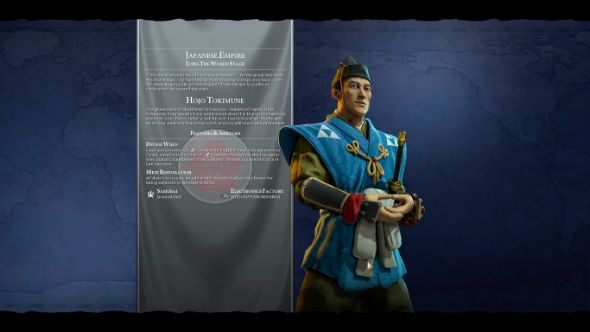
It takes me until the loading screen to figure out that the old way won’t work here. Japan’s perks, like all civs in this game, have been reworked. Now instead of fighting at full strength even if injured, most Japanese combat units instead gain +5 combat strength if they’re fighting near ocean tiles or in shallow water, thanks to the Divine Wind perk. That also means I can create Encampment, Holy Site and Theatre Square districts in my cities at twice the speed of other civs. Sounds like a good way to generate culture, but I’m not sure I want to commit to that tricky win condition on my first try at a new game.
Japan’s second big perk in Civ VI is Meiji Restoration, which provides an adjacency bonus for districts placed next to each other. It’s pretty clear that I’m going to be thinking a lot about districts in this playthrough – a feature I suspected may have been largely cosmetic when it was announced.
The Samurai do return in Civ VI, and they’re formidable Medieval foes as always. While other combat units have lost Bushido, injured Samurai still fight at full strength here. Good for them and everything, but without fishing boat generation it seems less of a no-brainer to make a beeline for them right away. They’re now strictly a combat option.
In the late game – much later than the 150 turns I’m allowed with this preview build – Japan will also gain electronics factories, another unique unit which provides bonus production and culture wherever it’s built. That’ll certainly colour late game tactics in the final release, but probably isn’t a building to shape your entire strategy around. And in any case, I won’t be building any today.
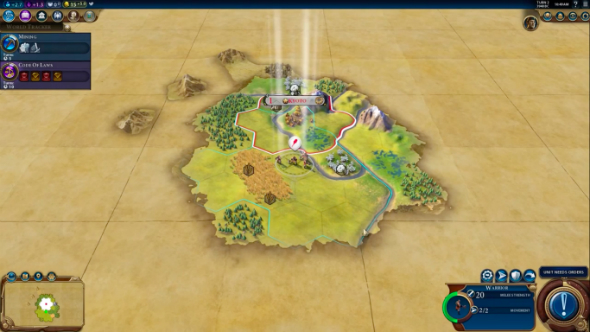
All of which is to say, when it comes to my first turn I commit cardinal Civ sin number one: not having a clear objective from the outset. Since the earliest entries to the series, the first 10-20 turns have been absolutely crucial in determining future successes and failures, but with new systems to learn I’m a bit panicky and decide to build a city immediately, in the tile my Settler spawns on.
It’s a tile adjacent to mountains on one side and a river on the other (thanks, spawn biases) so it’s a pretty good place to set up camp, as it turns out. Settling on turn one has been a valid option since forever in Civ games. No brainer.
Except… except it isn’t. Because in Civ VI it isn’t just your one city tile that matters. Surrounding features take on greater importance than in Civ V, because it’s on these tiles you’ll build your districts. Example: by sheer luck, Kyoto is in a good location because it’s two tiles away from a mountain, which means I can build a campus district between the two and gain a science bonus from that peak.
So really I’ve made two mistakes, building a city on the first tile I land on and not having a clear objective thereafter. Let’s not dwell, though. I set Kyoto to build a builder (but who builds the builders? Etc etc) which is again pretty standard practice since Civ III, and let my Warrior out on a Barbarian hunt. Within three turns he finds an adversary. But what’s this? A Barbarian Scout?
Barbarians work very differently in Civ VI, as I’m about to find out. They still spawn at those familiar encampments of spiked wooden stakes, but will now send out a Scout to find local settlements, and then report back to base to tell Barbarian Warriors who to harass. Poor Kyoto.
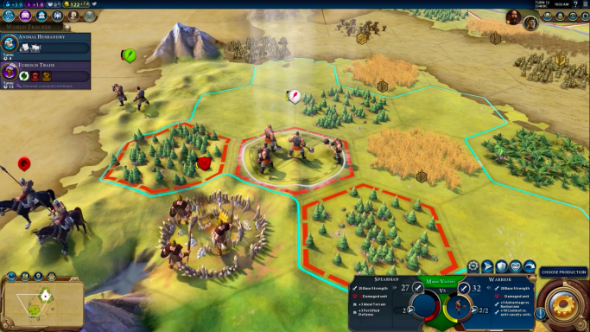
That means time is a factor when hunting down those Scout units. As ever they’re blessed with increased movement range per-turn over Warriors, so it takes me over ten turns to catch up with them. Or rather, for them to lead me back to the encampment where I can cease their spawning. When I do make it there, I find a garrison of Spearmen and a Cavalry unit waiting. Clever, clever brutes.
At this point I’m hugely outgunned, but since I’m playing on Prince difficulty they’re not terribly aggressive. I do away with the Spearmen easily, then size up those horses.
Meanwhile back at Kyoto, my Builder is ready for action. Since time immemorial I’ve set Workers (as they used to be known) to automate. Some people think that’s sacrilege, others swear by it. I’d build dozens of the industrious fellows and automate them all, building improvements willy-nilly.
Instinctively, I look for the ‘automate’ button. I can’t find it. I look for ‘build improvements’. No dice. Civ VI doesn’t want you to automate builders, not one bit. If you want to build an improvement, you send a Builder to a particular tile and tell them exactly what to build.
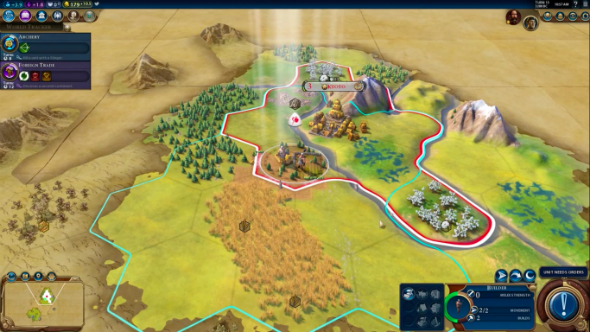
That strikes me as laborious at first, but after spending more time with the game and understanding a bit more about districts I don’t see a way for Builder automation to actually work here. Every tile in your territory is valuable – particularly playing as Japan, with adjacency bonuses available to districts – so you need to look at the map on a larger scale and plan decades into the future. What if I’d set my Builder to blithely improve tiles wherever and it built a farm on that tile between Kyoto and the mountain? That’s a campus district squandered.
Fortunately I figure that out before making any massive Builder blunders. Nevertheless, blunders are still incoming.
Having met Pedro II or Brazil and USA’s Teddy Roosevelt, I’m granted particular boosts to certain technologies. This is something 2K and Firaxis have described to an extent in their previews: if your city is next to the sea, you’ll be able to figure boats out faster than other peoples. By taking a Barbarian outpost, I gain a boost to military tradition research. Or, succinctly: doing things on the map shaves off the number of turns it takes to gain a tech.
It works well. Even if you’re feeling a bit directionless (absolutely guilty, at this point) it promotes the feeling that you’re making progress. It might even inspire a bold change of tactic. Having received boosts for meeting two leaders I consider doing just that, but before I have time I form a master plan disaster strikes.
Barbarians take my second Settler.
I can’t tell you how upsetting that is. I’d already left it a bit long to settle another city, so spent some cash on an instant unit purchase and sent it – unaccompanied – out to the west, where I knew ocean and food tiles awaited. Little did I know that a Barbarian Scout had already clocked it, grassed on me back at camp and set a Warrior out to stop me in my tracks.
And then Roosevelt declares war on me.

Right. Great. So to recap: I’m 41 turns in and still have just one city, Barbarians have just captured a Settler, my sole Warrior unit is many turns from home, and the States just declared an unprovoked, surprise war on me. Keep it together, mighty Hojo Tokimune.
Somehow I do keep it together, too. I spend a lot of gold on building two more Warrior units and an Archer (I gained a boost to archery by meeting Pedro II). The Americans do come, but their assault on Kyoto is half-hearted and can be kept at by by my improvised army. Even the chariot unit, which arrives from the west inspiring great dread among the beleaguered Japanese, only hangs around like a bystander to the actual fracas happening outside my capital.
Having pleaded with my old pal Pedro and newly acquainted Victoria I of Great Britain for some form of alliance to no avail, I finally return to Roosevelt after vanquishing a few of his units, hoping for an end to this senseless violence. Just as surprisingly as the moment he decided to declare war in the first place, he accepts my peace treaty instantly.
I still don’t completely understand what happened between he and I. Surprise and planned wars are a new diplomatic feature to Civ VI – the former carrying heavier Warmonger penalties later in the game but allowing the element of surprise, the latter subject to protocols but less frowned-upon by other leaders. I can only assume that Roosevelt (rightly) saw an opportunity to take a weaker civ early in the game, strictly business, no hard feelings.
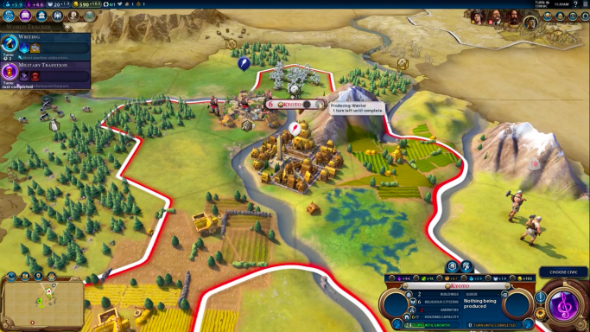
If you want to stay on better terms than that, leaders will give you much clearer clues about their objectives and personalities in this game. Roosevelt wants peace on his continent, so he’ll be angry with anyone who declares war near him. Victoria wants the continent to herself, so she’ll get upset at anyone settling near her. Pedro wants great people, and will be envious of other civs who attract them, and emperor Qin Shi Huang of China wants wonders. Don’t build wonders if you want to be friends. They’ll express those objectives and desires to you via diplomacy encounter cut-scenes, and there’s really no misinterpreting them.
It takes me a long time to steer the ship back on course, or indeed to set a course, but it happens. After resolving the USA war, I use my troops to ensure the next Settler I build gets to a coastal location safely. I build a campus district in Kyoto and start generating science at a respectable rate. I decide to go for a science victory.
Despite my many early setbacks, I find I haven’t actually lost much ground in the science stakes to rival leaders. Only China are ahead of me, and by the time I complete a campus in my second and third cities, I’m able to take the lead. To cap it all off, just before my 150 turns are up I’m even able to complete a wonder: The Great Library.
Yes, it should have been built a long time before 1400AD, but that’s hardly the point. Wonders are more context-dependent than ever in Civ VI so it really feels like an achievement to meet all the required criteria and get something built before anyone else. In my case it required not just an accelerated science output and a university, but a focus on wonder producting in my civics menu.
Civics is the last significant new system I sample this playthrough. If the tech tree unlocks new units and buildings, the civics tree unlocks little buffs and perks that you can choose in various configurations according to your government type. If you adopt a war-focussed government policy, you’ll be able to pick more civics cards that grant bonuses for soldier production, reduced unit maintenance costs and the like. If you decide to be more liberal, you’ll be able to pick more cards that boost science or culture production.
I didn’t spend enough time with the game to fairly assess whether this system works better or worse than Civ V’s social policies. The two are very similar, but there’s obviously a reason Firaxis chose to present the mechanics differently this time. That reason is, at this point, not evident.
The year 1400AD cometh. My 150 turns are up. For some reason, I’ve found myself pursuing a science victory with Japan and have made precisely no use of the race’s unique abilities or units. However, I’ve fought much harder than expected with Barbarians and unpredictible rival leaders. I’ve had to pay actual attention to districts, and in turn found a way to turn my game around and get back on track. And I’ve built a wonder. Secretly I presume I’ll be able to carry momentum forward to an eventual space-race victory, but I’ll have to wait and see about that. If nothing else, I’ve learned that Civ 6 plays sufficiently differently to the previous iteration I still hold in such high regard that I’m interested to play more of it.
